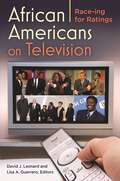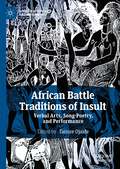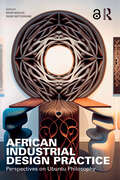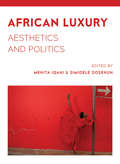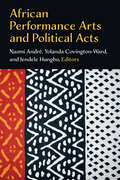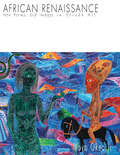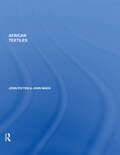- Table View
- List View
African Americans on Television: Race-ing for Ratings
by David J. LeonardA comprehensive look at the history of African Americans on television that discusses major trends in black TV and examines the broader social implications of the relationship between race and popular culture as well as race and representation.Previous treatments of the history of African Americans in television have largely lacked theoretical analysis of the relationship between representations and social contexts. African Americans on Television: Race-ing for Ratings fills the existing void by supplying fundamental history with critical analyses of the racial politics of television, documenting the considerable effect that television has had on popular notions of black identity in America since the inception of television.Covering a spectrum of genres—comedy, drama, talk shows, television movies, variety shows, and reality television, including shows such as Good Times, The Oprah Winfrey Show, and Chappelle's Show—this insightful work traces a cultural genealogy of African Americans in television. Its chronological analysis provides an engaging historical account of how African Americans entered the genre of television and have continued to play a central role in the development of both the medium and the industry. The book also tracks the shift in the significance of African Americans in the television market and industry, and the changing, but enduring, face of stereotypes and racism in American television culture.
African Americans on Television: Race-ing for Ratings
by David J. Leonard Lisa GuerreroA comprehensive look at the history of African Americans on television that discusses major trends in black TV and examines the broader social implications of the relationship between race and popular culture as well as race and representation.Previous treatments of the history of African Americans in television have largely lacked theoretical analysis of the relationship between representations and social contexts. African Americans on Television: Race-ing for Ratings fills the existing void by supplying fundamental history with critical analyses of the racial politics of television, documenting the considerable effect that television has had on popular notions of black identity in America since the inception of television.Covering a spectrum of genres—comedy, drama, talk shows, television movies, variety shows, and reality television, including shows such as Good Times, The Oprah Winfrey Show, and Chappelle's Show—this insightful work traces a cultural genealogy of African Americans in television. Its chronological analysis provides an engaging historical account of how African Americans entered the genre of television and have continued to play a central role in the development of both the medium and the industry. The book also tracks the shift in the significance of African Americans in the television market and industry, and the changing, but enduring, face of stereotypes and racism in American television culture.
African Art Now
by Osei BonsuOver the past two decades contemporary African art has taken its rightful place on the world stage. Today, African artists work outside the confines of limiting categories and outdated perceptions; they produce art that is as much a reflection of Africa's tumultuous past as it is a vision of its boundless future. African Art Now is an expansive overview featuring some of the most interesting and innovative artists working today. Far-reaching in its scope, this book celebrates the diversity and dynamism of the contemporary African art scene across the continent today.Featuring the work of Njideka Akunyili Crosby, Michael Armitage, Amoako Boafo, Cassi Namoda, Cinga Samson, Zina Saro-Wiwa and many more.
African Battle Traditions of Insult: Verbal Arts, Song-Poetry, and Performance (African Histories and Modernities)
by Tanure OjaideThis book explores the “battles” of words, songs, poetry, and performance in Africa and the African Diaspora. These are usually highly competitive, artistic contests in which rival parties duel for supremacy in poetry composition and/or its performance. This volume covers the history of this battle tradition, from its origins in Africa, especially the udje and halo of the Urhobo and Ewe respectively, to its transportation to the Americas and the Caribbean region during the Atlantic slave trade period, and its modern and contemporary manifestations as battle rap or other forms of popular music in Africa. Almost everywhere there are contemporary manifestations of the more traditional, older genres. The book is thus made up of studies of contests in which rivals duel for supremacy in verbal arts, song-poetry, and performance as they display their wit, sense of humor, and poetic expertise.
African Cultural Heritage Conservation and Management: Theory and Practice from Southern Africa
by Susan Osireditse KeitumetseFor a long time, resource conservationists have viewed environmental conservation as synonymous with wilderness and wildlife resources only, oblivious to the contributions made by cultural and heritage resources. However, cultural heritage resources in many parts of the developing world are gradually becoming key in social (e.g. communities’ identities and museums), economic (heritage tourism and eco-tourism), educational (curriculum development), civic (intergenerational awareness), and international resources management (e.g. UNESCO). In universities, African cultural heritage resources are facing a challenge of being brought into various academic discourses and syllabi in a rather reactive and/or haphazard approach, resulting in failure to fully address and research these resources’ conservation needs to ensure that their use in multiple platforms and by various stakeholders is sustainable. This book seeks to place African cultural heritage studies and conservation practices within an international and modern world discourse of conservation by presenting its varied themes and topics that are important for the development of the wider field of cultural heritage studies and management.
African Dress: Fashion, Agency, Performance (Dress, Body, Culture)
by Karen Tranberg HansenDress and fashion practices in Africa and the diaspora are dynamic and diverse, whether on the street or on the fashion runway. Focusing on the dressed body as a performance site, African Dress explores how ideas and practices of dress contest or legitimize existing power structures through expressions of individual identity and the cultural and political order.Drawing on innovative, interdisciplinary research by established and up and coming scholars, the book examines real life projects and social transformations that are deeply political, revolving around individual and public goals of dignity, respect, status, and morality.With its remarkable scope, this book will attract students and scholars of fashion and dress, material culture and consumption, performance studies, and art history in relation to Africa and on a global scale.
African Dress: Fashion, Agency, Performance (Dress, Body, Culture)
by Karen Tranberg Hansen D. Soyini MadisonDress and fashion practices in Africa and the diaspora are dynamic and diverse, whether on the street or on the fashion runway. Focusing on the dressed body as a performance site, African Dress explores how ideas and practices of dress contest or legitimize existing power structures through expressions of individual identity and the cultural and political order.Drawing on innovative, interdisciplinary research by established and up and coming scholars, the book examines real life projects and social transformations that are deeply political, revolving around individual and public goals of dignity, respect, status, and morality.With its remarkable scope, this book will attract students and scholars of fashion and dress, material culture and consumption, performance studies, and art history in relation to Africa and on a global scale.
African Film Studies: An Introduction
by Boukary SawadogoAfrican Film Studies: An Introduction is an accessible and authoritative textbook on African cinema as a field of study. The book provides a succinct and comprehensive study of the history, aesthetics, and theory of sub-Saharan African cinematic productions that is grounded in the field of film studies instead of textual interpretations from other disciplines. Bringing African cinema out of the margins into the discipline of mainstream film studies and showcasing the diverse cinematic expressions of the continent, the book covers: Overview of African cinema(s): Questions our assumptions about the continent’s cinematic productions and defines the characteristics of African cinema across linguistic, geographic, and filmic divides. History of African and African-American cinema: Spans the history of film in Africa from colonial import and ‘appropriation of the gaze’ to the quest for individuality. It also establishes parallels in the historical development of black African cinema and African-American cinema. Aesthetics: Introduces new research on previously unexplored aesthetic dimensions such as cinematography, animation, and film music. Theoretical Approaches: Addresses a number of theoretical approaches and critical frameworks developed by scholars in the study of African cinema All chapters include case studies, suggestions for further reading, and screening lists to deepen the reader’s knowledge with no prior knowledge of African cinema required. Students, teachers, and general film enthusiasts would all benefit from this accessible and engaging book.
African Film Studies: An Introduction
by Boukary SawadogoAfrican Film Studies: An Introduction is an accessible and authoritative textbook on African cinema as a field of study. The book provides a succinct and comprehensive study of the history, aesthetics, and theory of sub-Saharan African cinematic productions that is grounded in the field of film studies instead of textual interpretations from other disciplines. Bringing African cinema out of the margins into the discipline of mainstream film studies and showcasing the diverse cinematic expressions of the continent, the book covers: Overview of African cinema(s): Questions our assumptions about the continent’s cinematic productions and defines the characteristics of African cinema across linguistic, geographic, and filmic divides. History of African and African-American cinema: Spans the history of film in Africa from colonial import and ‘appropriation of the gaze’ to the quest for individuality. It also establishes parallels in the historical development of black African cinema and African-American cinema. Aesthetics: Introduces new research on previously unexplored aesthetic dimensions such as cinematography, animation, and film music. Theoretical Approaches: Addresses a number of theoretical approaches and critical frameworks developed by scholars in the study of African cinema All chapters include case studies, suggestions for further reading, and screening lists to deepen the reader’s knowledge with no prior knowledge of African cinema required. Students, teachers, and general film enthusiasts would all benefit from this accessible and engaging book.
African Film Studies: An Introduction
by Boukary SawadogoAfrican Film Studies is an accessible and engaging introduction to African cinemas, showcasing the diverse cinematic expressions across the continent. Bringing African cinemas out of the margins and into mainstream film studies, the book provides a succinct overview of the history, aesthetics, and theory of sub-Saharan African cinematic productions. Updated throughout, this new edition includes new chapters on Nollywood, Ethiopian cinema, Streaming, and the rise of televisual series, which serve to complement the book’s main themes: • Overview of African cinema(s): Questions assumptions and defines the characteristics of African cinemas across linguistic, geographic, and filmic divides. • History of African cinemas: Spans the history of film in Africa from colonial import and ‘appropriation of the gaze’, the rise of Nollywood and local TV series to streaming, as well as building connections with the development of African American cinema. • Aesthetics: Introduces new research on previously under-explored aesthetic dimensions such as cinematography, animation, and film music. • Theoretical Approaches: Addresses a number of theoretical approaches and critical frameworks developed by scholars in the study of African cinemas. • Traditions and practices in African screen media: Features Ethiopian cinema, Nollywood, Local Televisual Series in Burkina Faso and South Africa, and the Streaming rush for Africa. All chapters include case studies, suggestions for further reading, and screening lists to deepen the reader’s knowledge, with no prior knowledge of African cinemas required. Students, teachers, and general film enthusiasts would all benefit from this accessible and engaging book.
African Film Studies: An Introduction
by Boukary SawadogoAfrican Film Studies is an accessible and engaging introduction to African cinemas, showcasing the diverse cinematic expressions across the continent. Bringing African cinemas out of the margins and into mainstream film studies, the book provides a succinct overview of the history, aesthetics, and theory of sub-Saharan African cinematic productions. Updated throughout, this new edition includes new chapters on Nollywood, Ethiopian cinema, Streaming, and the rise of televisual series, which serve to complement the book’s main themes: • Overview of African cinema(s): Questions assumptions and defines the characteristics of African cinemas across linguistic, geographic, and filmic divides. • History of African cinemas: Spans the history of film in Africa from colonial import and ‘appropriation of the gaze’, the rise of Nollywood and local TV series to streaming, as well as building connections with the development of African American cinema. • Aesthetics: Introduces new research on previously under-explored aesthetic dimensions such as cinematography, animation, and film music. • Theoretical Approaches: Addresses a number of theoretical approaches and critical frameworks developed by scholars in the study of African cinemas. • Traditions and practices in African screen media: Features Ethiopian cinema, Nollywood, Local Televisual Series in Burkina Faso and South Africa, and the Streaming rush for Africa. All chapters include case studies, suggestions for further reading, and screening lists to deepen the reader’s knowledge, with no prior knowledge of African cinemas required. Students, teachers, and general film enthusiasts would all benefit from this accessible and engaging book.
African Industrial Design Practice: Perspectives on Ubuntu Philosophy
by Richie Moalosi Yaone RapitsenyaneThe underlying principle of this book is the African philosophy of Ubuntu, which acts as a guide for developing empathic products and services. The book makes the case that empathy is the key to any successful product and service design project because it enables designers to make wise design choices that align with users' demands.Fifteen chapters provide the latest industrial design developments, techniques, and processes explicitly targeting emerging economies. At the outset, it covers the design context and the philosophy of the Ubuntu approach, which places people and communities at the centre of the development agenda. The book covers new product development, design research, design cognition, digital and traditional prototyping, bringing products to the market, establishing a company's brand name, intellectual property rights, traditional knowledge, and the business case for design in Afrika. It concludes with a discussion about the future of design and the skills aspiring designers will need.African Industrial Design Practice: Perspectives on Ubuntu Philosophy will be an essential textbook for undergraduates, postgraduates, instructors, and beginner designers in emerging economies to provide regionally contextualised design processes, illustrated examples, and outcomes.Chapter 2 of this book is freely available as a downloadable Open Access PDF at http://www.taylorfrancis.com under a Creative Commons Attribution-Non Commercial-No Derivatives (CC-BY-NC-ND) 4.0 license.
African Industrial Design Practice: Perspectives on Ubuntu Philosophy
The underlying principle of this book is the African philosophy of Ubuntu, which acts as a guide for developing empathic products and services. The book makes the case that empathy is the key to any successful product and service design project because it enables designers to make wise design choices that align with users' demands.Fifteen chapters provide the latest industrial design developments, techniques, and processes explicitly targeting emerging economies. At the outset, it covers the design context and the philosophy of the Ubuntu approach, which places people and communities at the centre of the development agenda. The book covers new product development, design research, design cognition, digital and traditional prototyping, bringing products to the market, establishing a company's brand name, intellectual property rights, traditional knowledge, and the business case for design in Afrika. It concludes with a discussion about the future of design and the skills aspiring designers will need.African Industrial Design Practice: Perspectives on Ubuntu Philosophy will be an essential textbook for undergraduates, postgraduates, instructors, and beginner designers in emerging economies to provide regionally contextualised design processes, illustrated examples, and outcomes.Chapter 2 of this book is freely available as a downloadable Open Access PDF at http://www.taylorfrancis.com under a Creative Commons Attribution-Non Commercial-No Derivatives (CC-BY-NC-ND) 4.0 license.
African Lace-bark in the Caribbean: The Construction of Race, Class, and Gender
by Steeve O. BuckridgeIn Caribbean history, the European colonial plantocracy created a cultural diaspora in which African slaves were torn from their ancestral homeland. In order to maintain vital links to their traditions and culture, slaves retained certain customs and nurtured them in the Caribbean. The creation of lace-bark cloth from the lagetta tree was a practice that enabled slave women to fashion their own clothing, an exercise that was both a necessity, as clothing provisions for slaves were poor, and empowering, as it allowed women who participated in the industry to achieve some financial independence.This is the first book on the subject and, through close collaboration with experts in the field including Maroon descendants, scientists and conservationists, it offers a pioneering perspective on the material culture of Caribbean slaves, bringing into focus the dynamics of race, class and gender. Focussing on the time period from the 1660s to the 1920s, it examines how the industry developed, the types of clothes made, and the people who wore them. The study asks crucial questions about the social roles that bark cloth production played in the plantation economy and colonial society, and in particular explores the relationship between bark cloth production and identity amongst slave women.
African Lace-bark in the Caribbean: The Construction of Race, Class, and Gender
by Steeve O. BuckridgeIn Caribbean history, the European colonial plantocracy created a cultural diaspora in which African slaves were torn from their ancestral homeland. In order to maintain vital links to their traditions and culture, slaves retained certain customs and nurtured them in the Caribbean. The creation of lace-bark cloth from the lagetta tree was a practice that enabled slave women to fashion their own clothing, an exercise that was both a necessity, as clothing provisions for slaves were poor, and empowering, as it allowed women who participated in the industry to achieve some financial independence.This is the first book on the subject and, through close collaboration with experts in the field including Maroon descendants, scientists and conservationists, it offers a pioneering perspective on the material culture of Caribbean slaves, bringing into focus the dynamics of race, class and gender. Focussing on the time period from the 1660s to the 1920s, it examines how the industry developed, the types of clothes made, and the people who wore them. The study asks crucial questions about the social roles that bark cloth production played in the plantation economy and colonial society, and in particular explores the relationship between bark cloth production and identity amongst slave women.
The African Lookbook: A Visual History of 100 Years of African Women
by Catherine E. McKinleyAn unprecedented visual history of African women told in striking and subversive historical photographs--featuring an Introduction by Edwidge Danticat and a Foreword by Jacqueline Woodson.Most of us grew up with images of African women that were purely anthropological--bright displays of exotica where the deeper personhood seemed tucked away. Or they were chronicles of war and poverty--“poverty porn.” But now, curator Catherine E. McKinley draws on her extensive collection of historical and contemporary photos to present a visual history spanning a hundred-year arc (1870–1970) of what is among the earliest photography on the continent. These images tell a different story of African women: how deeply cosmopolitan and modern they are in their style; how they were able to reclaim the tools of the colonial oppression that threatened their selfhood and livelihoods.Featuring works by celebrated African masters, African studios of local legend, and anonymous artists, The African Lookbook captures the dignity, playfulness, austerity, grandeur, and fantasy-making of African women across centuries. McKinley also features photos by Europeans--most starkly, striking nudes--revealing the relationships between white men and the Black female sitters where, at best, a grave power imbalance lies. It's a bittersweet truth that when there is exploitation there can also be profound resistance expressed in unexpected ways--even if it's only in gazing back. These photos tell the story of how the sewing machine and the camera became powerful tools for women's self-expression, revealing a truly glorious display of everyday beauty.
African Luxury: Aesthetics and Politics
by Mehita Iqani Simidele DosekunMoving far beyond predominant views of Africa as a place to be 'saved', and even more recent celebratory formulations of it as 'rising', African Luxury: Aesthetics and Politics highlights and critically interrogates the visual and material cultures of lavish and luxurious consumption already present on the continent.
African Performance Arts and Political Acts (African Perspectives)
by Naomi Andre Yolanda Covington-Ward Jendele HungboAfrican Performance Arts and Political Actspresents innovative formulations for how African performance and the arts shape the narratives of cultural history and politics. This collection, edited by Naomi André, Yolanda Covington-Ward, and Jendele Hungbo, engages with a breadth of African countries and art forms, bringing together speech, hip hop, religious healing and gesture, theater and social justice, opera, radio announcements, protest songs, and migrant workers’ dances. The spaces include village communities, city landscapes, prisons, urban hostels, Township theaters, opera houses, and broadcasts through the airwaves on television and radio as well as in cyberspace. Essays focus on case studies from Cameroon, the Democratic Republic of the Congo, Nigeria, Senegal, South Africa, and Tanzania.
The African Photographic Archive: Research and Curatorial Strategies
by Christopher MortonAfrican photography has emerged as a significant focus of research and scholarship over the last twenty years, the result of a growing interest in postcolonial societies and cultures and a turn towards visual evidence across the humanities and social sciences. At the same time, many rich and fascinating photographic collections have come to light. This volume explores the complex theoretical and practical issues involved in the study of African photographic archives, based on case studies drawn from across the continent dating from the 19th century to the present day. Chapters consider what constitutes an archive, from the familiar mission and state archives to more local, vernacular and personal accumulations of photographs; the importance of a critical and reflexive engagement with photographic collections; and the question of where and what is ‘Africa’, as constructed in the photographic archive. Essential reading for all researchers working with photographic archives, this book consolidates current thinking on the topic and sets the agenda for future research in this field.
The African Photographic Archive: Research and Curatorial Strategies
by Christopher Morton Darren NewburyAfrican photography has emerged as a significant focus of research and scholarship over the last twenty years, the result of a growing interest in postcolonial societies and cultures and a turn towards visual evidence across the humanities and social sciences. At the same time, many rich and fascinating photographic collections have come to light. This volume explores the complex theoretical and practical issues involved in the study of African photographic archives, based on case studies drawn from across the continent dating from the 19th century to the present day. Chapters consider what constitutes an archive, from the familiar mission and state archives to more local, vernacular and personal accumulations of photographs; the importance of a critical and reflexive engagement with photographic collections; and the question of where and what is 'Africa', as constructed in the photographic archive. Essential reading for all researchers working with photographic archives, this book consolidates current thinking on the topic and sets the agenda for future research in this field.
The African Photographic Archive: Research and Curatorial Strategies
by Christopher Morton Darren NewburyAfrican photography has emerged as a significant focus of research and scholarship over the last twenty years, the result of a growing interest in postcolonial societies and cultures and a turn towards visual evidence across the humanities and social sciences. At the same time, many rich and fascinating photographic collections have come to light. This volume explores the complex theoretical and practical issues involved in the study of African photographic archives, based on case studies drawn from across the continent dating from the 19th century to the present day. Chapters consider what constitutes an archive, from the familiar mission and state archives to more local, vernacular and personal accumulations of photographs; the importance of a critical and reflexive engagement with photographic collections; and the question of where and what is ‘Africa’, as constructed in the photographic archive. Essential reading for all researchers working with photographic archives, this book consolidates current thinking on the topic and sets the agenda for future research in this field.
African Renaissance
by M OkedijiAfrican Renaissance: New Forms, Old Images in Yoruba Art describes, analyzes, and interprets the historical and cultural contexts of an African art renaissance using the twentieth- and twenty-first-century transformation of ancient Yoruba artistic heritage. Juxtaposing ancient and contemporary Yoruba art, Moyo Okediji defines this art history through the lens of colonialism, an experience that served to both destroy ancient art traditions and revive Yoruba art in the twentieth century. With vivid reproductions of paintings, prints, and drawings, Okediji describes how Yoruba art has replenished and redefined itself. Okediji groups the text into several broadly overlapping periods that intricately detail the journey of Yoruba art and artists: first through oppression by European colonialism, then the attainment of Nigeria’s independence and the new nation’s subsequent military coup, and ending with present-day native Yoruban artists fleeing their homeland.
African Roots, Brazilian Rites: Cultural and National Identity in Brazil
by C. SterlingThis text explores how Afro-Brazilians define their Africanness through Candomblé and Quilombo models, and construct paradigms of blackness with influences from US-based perspectives, through the vectors of public rituals, carnival, drama, poetry, and hip hop.
African Textiles
by J. PictonAn illustrated survey of African textiles - their design, manufacture, and use - as part of African life, art, and culture.
African Textiles
by J. PictonAn illustrated survey of African textiles - their design, manufacture, and use - as part of African life, art, and culture.
